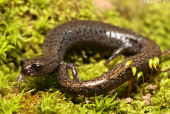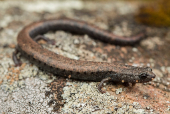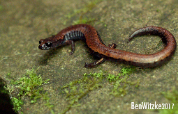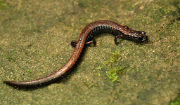Lesser Slender Salamander (Batrachoseps minor)
Description: Adults are 1 to 2 3/10 inches long from snout to vent. A small, slim salamander, the smallest of the Slender Salamanders (Batrachoseps), with 17 to 18 costal grooves, a short body, fairly long legs, and a broad head with a distinct neck. The eyes are slightly protuberant. Small size, short limbs, a long slender body with a narrow head and a long tail, and conspicuous costal and caudal grooves give this species the worm-like appearance typical of most Slender Salamanders. There are 5 to 8 costal folds between adpressed limbs. There are four toes on the front and hind feet, which is typical of Slender Salamanders. (Other salamanders found in California have five toes on the hind feet.) Color is blackish brown, sometimes with a tan dorsal stripe, with pinkish or apricot highlights, most noticable on the tail.
Habitat: Inhabits moist locations in forests of mixed oak, tanbark oak, sycamore and laurel above 1,300 feet.
Range: Endemic to California. Found only in a small area in the southern Santa Lucia Mountains of San Luis Obispo county.
Found in these States:
CA
Diet: Most likely eats a variety of small invertebrates. Feeding behavior is not well known, but other Batrachoseps species are sit-and-wait predators that use a projectile tongue to catch prey.
Reproduction: Little is known about the breeding behavior and egg-laying habits of this species. Reproduction is terrestrial. Other female Slender Salamanders lay eggs in moist places underground. Young develop completely in the egg and hatch fully formed.
Status: Listed as Endangered because its extent of occurrence (EOO) is 411 km2, it occurs in five or fewer threat-defined locations, and there is continuing decline in the extent and quality of its habitat.
»» Kingdom: Animalia - Animals
»» Phylum: Chordata - Chordates
»» Subphylum: Vertebrata - Vertebrates
»» Class: Amphibia - (Amphibians)
»» Order: Caudata - Salamanders
»» Family: Plethodontidae - Lungless Salamanders
»» Genus: Batrachoseps
»» Species: Batrachoseps minor - Lesser Slender Salamander
This article uses material from the Wikipedia article "Lesser Slender Salamander", which is released under the Creative Commons Attribution-Share-Alike License 3.0. Content may have been omitted from the original, but no content has been changed or extended.
|












